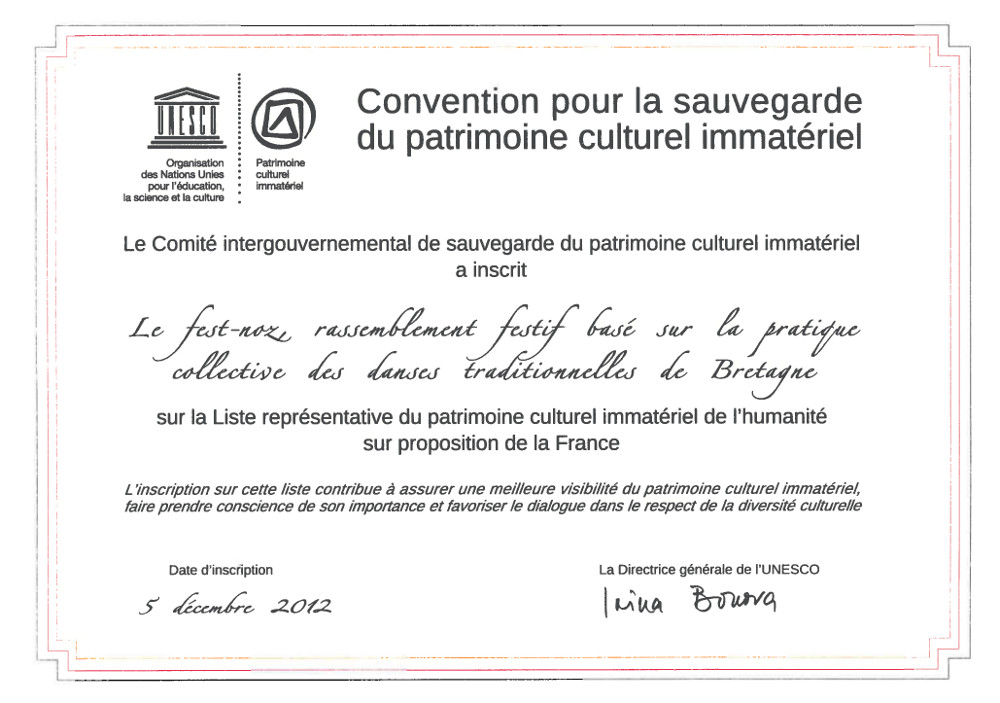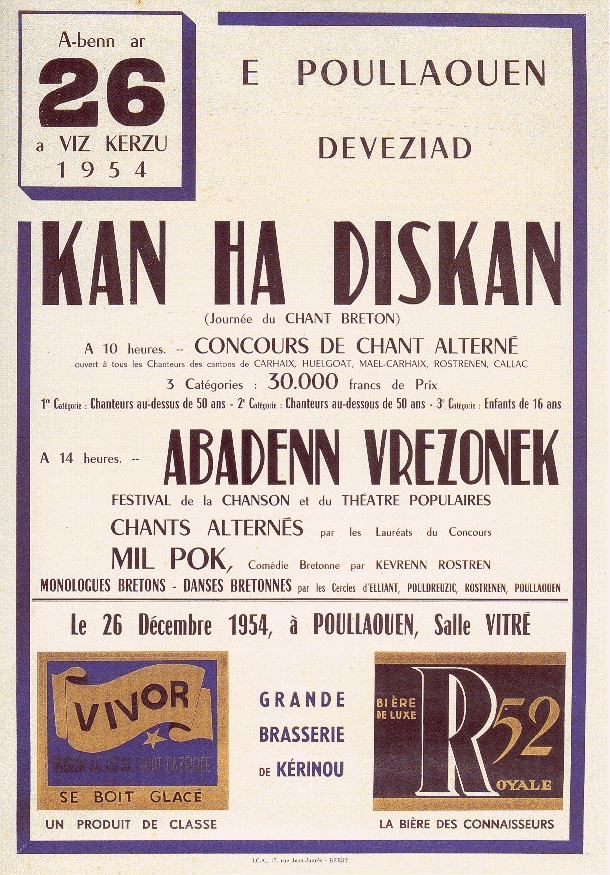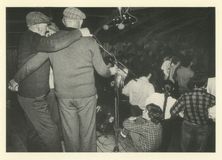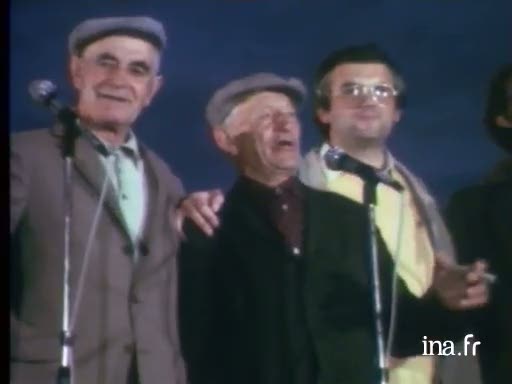At the start of the 20th century, the fest-noz, a celebration which had always accompanied the long days of shared labour in areas in Central Brittany, was well on its way to extinction in favour of indoor balls animated by accordion players, or small bands: representatives of a new, modern way of life. The last official fest-noz in Poullaouen was held in 1930, after which these traditionally singer-led dances were limited to post-harvest celebrations, for example, which were held almost in secret. The tradition undoubtedly remained more lively in the Fisel area of north Cornouaille, between Maël-Carhaix and Rostrenen.
From that time onwards, Loeiz Ropars began working to save the kan ha diskan singing tradition. He had been a member of a dance group in Poher, established by Taldir Jaffrenou, and in July 1939, he founded a new group called Mesarien Poullaouen (The Shepherds of Poullaouen).
During the German Occupation, as the population retreated to the countryside, there was also a retreat to days of old. For a short time, between 1942 and 1943, the fest-noz reaped the benefits of this. But as soon as the Second World War was over, only around ten villages continued to organise festoù-noz, with only a handful of singer couples who could lead the dances still in existence.
Kan ha diskan Competitions and the Fest-Noz Revival
Loeiz Ropars became a teacher in Quimper in 1946, where he founded a group which, from 1947, formed the beginnings of Quimper’s Celtic circle. Then in 1949, he founded a circle in Poullaouen (this time officially), which organised dances led by singer couples throughout Brittany, as well as further afield. In parallel, he made radio appearances, taught dance…and also a Breton piper.
All the effort he put into reviving singer-led dancing on the radio and during festivals helped to establish a following of Breton song and dance amateurs, who would travel to celebrate these, as long as the event promised to be original and engaging..., hence the idea of a kan ha diskan competition with prizes. And so on 26th December 1954, the first kan ha diskan competition was held in Poullaouen. It was a huge success. Further competitions were organised in Poullouaen in 1955 and 1956; then in Spézet in 1957 (where a kan ha diskan day had already been held in 1955 thanks to Yves Le Com); in 1958 in Châteauneuf; and in Gourin in 1959.
By this point, Loeiz Ropars believed he had achieved his intended objective; he’d brought back singer couples when only one remained in Poullaouen in 1954: François-Louis Gall and François Jaffré, who had both been part of the Poullaouen Celtic circle since 1950.
Whilst on a course organised by Ar Falz in Brehec, Côtes-d’Armor, in September 1955, encouraged by his sister Eugénie, Loeiz Ropars decided to take his course colleagues to Poullaouen, where he introduced them to the traditions of song and dance. It was the perfect occasion to arrange an evening that was to be half show, half fest-noz and the event was more successful than he could ever have hoped. Not only did all his colleagues attend, but also a huge number of Poullaouen locals. The evening is one of the first examples of the modern fest-noz: it took place in a village hall, rather than on a farm, and the singers were not part of the dancing, standing instead on a stage with a microphone.
There are other similar fest-noz revival stories, for example in Plonévez-du-Faou in 1956. And in 1957, the Ar Falz course gave rise to six festoù-noz in the Glomel area. Meanwhile, the Kendalc’h confederacy of Celtic circles was busy organising festoù-noz in Cléden-Poher…and even Paris.
From Fest-Noz to Bal Breton.
But the ultimate fest-noz resurgence took place in Poullaouen and Saint Herbot in September and December 1957. Locals were joined by amateur musicians, singers and dancers, some of whom had travelled from afar. The dances were no longer simply led by singers. Bagpipe duo Étienne Rivoallan and Georges Cadoudal also accompanied them. The events were a great success and their blueprint was soon copied. The people of Saint-Servais held their first fest-noz in 1958, hosted by the Morvan brothers. That same year in November, thanks to twon half Secretary Mr Tressard, a fest-noz evening was hosted in Treffrin by Albert Trévidic, during which Tanon and Tasie Goadec made an appearance. They were later joined by their three other sisters. From then on, Festoù-noz were a regular occurrence in Central Brittany, with even an Amicale des festoù-noz group being formed in the area at the beginning 1960s.
Loeiz Ropars also realised that if he wanted results, he had to spread the word in towns and cities, in order to appeal to a younger generation. And since that generation did not listen to traditional Breton songs, or even Breton music, he had an idea for a particular type of event. In April 1958, he organised the very first bal breton for his pupils studying Breton at the high school in Quimper. He explained, “I had to organise an event that would appeal to the greatest number of people, to people who weren’t part of a Celtic circle, and so we needed to leave out the dances that were too difficult for beginners. Yvon Palamour, Jude Le Paboul and I agreed on a specific variant of the an dro, or hanter dro, which we taught everyone. We chose dance steps that increased in difficulty: the easiest first, from the Pach pi, before adding in the steps from the An dro, the Hanter dro, and the Gavotte. After a very quick introduction to the steps, anybody could join in the dancing, especially since the choreography would regularly repeat itself throughout the evening.” Quimper high school’s bal breton became an institution and from 1964, the Fêtes de Cornouaille included a bal breton/fest-noz evening in their programme.
During the 1960s, fest-noz events increased in number throughout Central Brittany and even started to appear in other parts of the region where, a few years earlier, the term had been totally unknown. Like many other architects of the revival, Loeiz Ropars could never have imagined just how enthusiastically people would welcome the fest-noz, or that the term would subsequently be added to French dictionaries. Harder still to imagine that the fest-noz would become part of UNESCO’s inventory for Intangible Cultural Heritage.
Translated by Tilly O'Neill









